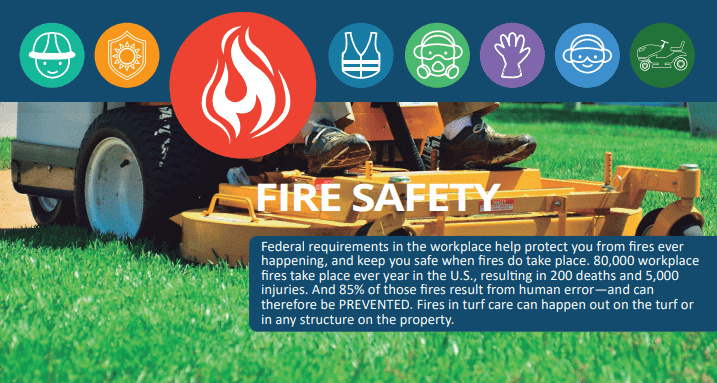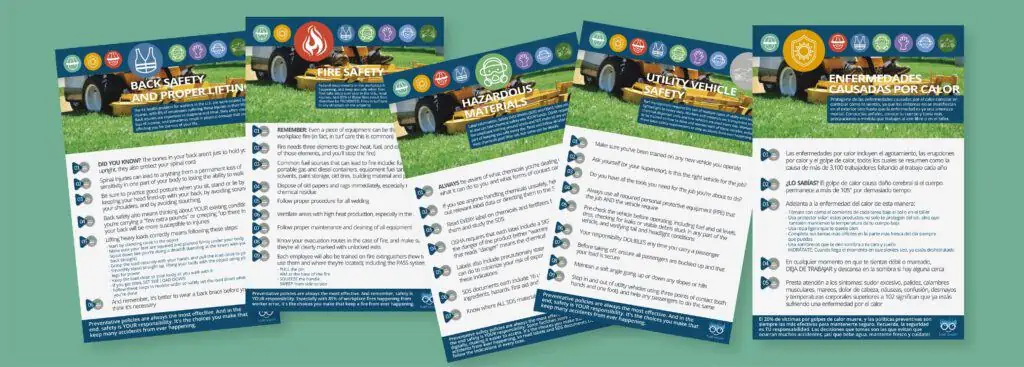
A fire is both one of the most common and also the most devastating hazards that a workplace needs to prepare for.
Fires in the turf care industry can happen almost anywhere—out on the turf, in the shop or in any other structure on the property. And because 80,000 workplace fires take place every year in the U.S.—resulting in 200 deaths and 5,000 injuries—you need to know what actions to take to keep you and your coworkers safe.
Even though the basics of fire safety may seem like common sense, we’re going to break down the less-intuitive parts of fire safety and prevention. It only takes one accident to turn a normal workday into a disaster.
Do you know the most common sources of workplace fires? Would you know what to do in case of a fire? Are you familiar with different types of fire extinguishers and how to use them? Your safety is our first priority, and only you can prevent catastrophic accidents before they happen.
Common sources of workplace fires
It’s common in turf care for a piece of equipment to be the source of a workplace fire, especially those that have to do with any type of fuel. Common fuel sources that can lead to fire include fueling stations, portable gas and diesel containers, equipment fuel tanks, cleaning solvents, paint storage, old tires, building materials and paper storage containers.
The best way to prevent an accidental fire is to pay close attention to the proper transport and storage of these materials. Always store flammable materials in a cool, dark area if you can. You should also follow the proper maintenance and cleaning procedure for all equipment.
Dispose of old papers and rags immediately, especially rags with chemical residue. Chemical fires are more dangerous than any other fires and can be more difficult to extinguish.
It’s easy for fires to start in areas with high heat production, especially the shop. Ventilation will help to prevent fires in areas with high heat production. Always take extra care when welding or operating machinery in tight quarters.
In case of a fire
Should a fire occur, there are a few safety procedures you need to be aware of. If you see a fire, alert everyone in the vicinity to evacuate. Trigger the fire alarm or shout if you cannot find one.
Know whether to evacuate or to attempt to put out the fire. If the fire looks too large to put out within 10 seconds, it is too large for a fire extinguisher.
If you need to evacuate, use the nearest exit. A fire evacuation route should be known by everyone at your workplace, and every exit should be clearly marked and unlocked at all times.
A fire needs three elements to grow: heat, fuel and oxygen. Cut off any of those elements and the fire will stop. As you are evacuating, close doors behind you, but don’t lock them! This will hopefully stop the fire from spreading while still ensuring everyone can access the evacuation route.
Fire extinguishers
First and foremost, do not attempt to put out a fire if your or other’s safety is at risk or if the fire is too large. That said, everyone should be trained on how to properly use a fire extinguisher.
Different fire extinguishers only work on specific classifications of fires. Fires are classified using an A, B and C-class rating system. A fire’s rating is based on the fire’s fuel source.
Not all fire extinguishers work for all types of fires. Knowing which extinguisher to use could save your life. The class of fire and extinguisher can extinguish is listed on every fire extinguisher. It’s your responsibility to read the label and make the best choice for the situation at hand.
To put out a fire by using a fire extinguisher, simply follow the PASS method:
Pull
· Pull the pin on the fire extinguisher.
Aim
· Aim the extinguisher at the base of the fire.
Squeeze
· Squeeze the handle.
Sweep
· Sweep side to side at the base of the fire until it is extinguished.
This method is easy to use, easy to remember and effective.
Takeaways
Sources say up to 85% of workplace fires are the result of human error. At the end of the day, your safety is too important to be left up to chance. It’s the choices you make that keep fires from happening. Know what materials can cause fires, how to assess the risk a fire poses and how to extinguish a fire before it grows out of control. The safety of you and your coworkers depends on it.
